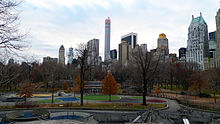History of landscape architecture

The discussion of the history of landscape architecture is a complex endeavor as it shares much of its history with that of
Earliest history
For the period before 1800, the history of landscape architecture, formally landscape gardening, is largely that of master planning and
The first person to write of "making" a landscape was Joseph Addison in a series of essays entitled "On the Pleasures of the Imagination" in 1712[2]
The term landscape architecture was first used by Gilbert Laing Meason in his book On The Landscape Architecture of the Great Painters of Italy (London, 1828). Meason was born in Scotland and did not have the opportunity to visit Italy, but he admired the relationship between architecture and landscape in the great landscape paintings and drew upon Vitruvius' Ten Books on Architecture to find principles and the relationship between built form and natural form.[3] The term was then taken up by John Claudius Loudon and used to describe a specific type of architecture, suited to being placed in designed landscapes.[1] Loudon was admired by the American designer and theorist Andrew Jackson Downing and landscape architecture was the subject of a chapter in Downing's book A Treatise on the Theory and Practice of Landscape Gardening, Adapted to North America (1841).[4]
First years

This led to its adoption by
Modern time
Landscape architecture has since become a worldwide profession, submitted for recognition by the International Labour Organization[7] and represented on a world-wide basis by the International Federation of Landscape Architects.[8]
Several landscape architects practicing in the 1980s and 1990s moved the discipline beyond its roots in High Modernism. These include Martha Schwartz, Peter Walker, and Michael Van Valkenburgh. Starting in the mid-1990s, a new disciplinary shift occurred toward what has been called Landscape urbanism, a term that attempts to merge urban design, infrastructure design and landscape.
Publications
Three remarkable histories of the landscape architecture profession were published in the 1970s.
A first comprehensive history of landscape architecture, as distinct from the
A second comprehensive history of landscape architecture with the title History of Landscape Architecture was published in 1973 by George B Tobey. It extends from 5000 BC, through the development of agriculture and towns to the design of gardens, parks and garden cities. This represents a broader view of landscape architecture than that of Newton and would have been well suited to Newton's title 'Design on the land'.[10]
A third comprehensive history of landscape architecture was published by
Related fine arts and representation
The fine arts and landscape architecture have been interwoven in the outstanding professionals' methods. A history of landscape architecture, including the natural and designed the landscape and of public and private gardens: also includes the crucial professional component of artistic and technical representation, which have always been responsible for visualizing and communicating – the creative concepts, ideas, designs, options, 'manifested theories', and guiding aesthetic principles – between the landscape architect and the clients, builders, and interested parties.
A few of the media and methods are unchanged, while most have evolved over the centuries to reflect new artistic methods and graphic supplies. Almost timeless are the fine arts media of charcoal sketch, oil paint,
. Those were joined by: print-making; by film photography for prints, slides, and movies; collage and built-up layered images; model making, and other techniques. Since the late 20th century the introduction of computers, numerous formatting uses for scanning and printing, the wide array of options with digital technology for drawing, images and site videos; and the nearly infinite reach of the internet have revolutionized how to explore and interact to share creative intent. These have also facilitated effective communication collaboratively within the project team, clients, and involved people of the world.Related fine arts
Two-dimensional artsPhotography
Digital art
|
Three-dimensional artsSculptureLand or Earth art
|
See also
- History of gardening
- Landscape architecture
- Landscape planning
- History of Parks and Gardens of Paris
References
- ^ a b Loudon, John Claudius (1840). The landscape gardening and landscape architecture of the late Humphry Repton.
- JSTOR 24636000.
- ^ Meason, Gilbert Laing (1828). On the landscape architecture of the great painters of Italy.
- ^ Downing, Andrew Jackson (1841). A treatise on the theory and practice of landscape gardening, adapted to North America.
- ^ "Olmsted—His Essential Theory - National Association for Olmsted Parks". www.olmsted.org. Retrieved 2019-01-06.
- ^ "Frederick Law Olmsted". The Emerald Necklace Conservancy. Retrieved 2019-01-06.
- ^ "Updating the International Standard Classification of Occupations (ISCO) | Draft ISCO-08 Group Definitions: Occupations in Design" (PDF). www.ilo.org. Retrieved 2019-01-06.
- ^ "International Federation of Landscape Architects". Archived from the original on 2012-11-22. Retrieved 2019-01-06.
- ISBN 9780674198708.
- ISBN 9780444001313.
- ^ ISBN 9780442245658.
- ISBN 9780750622677.
Further reading
- The profession of Landscape Architecture in Australia originally published by Margaret Hendry in 1997
